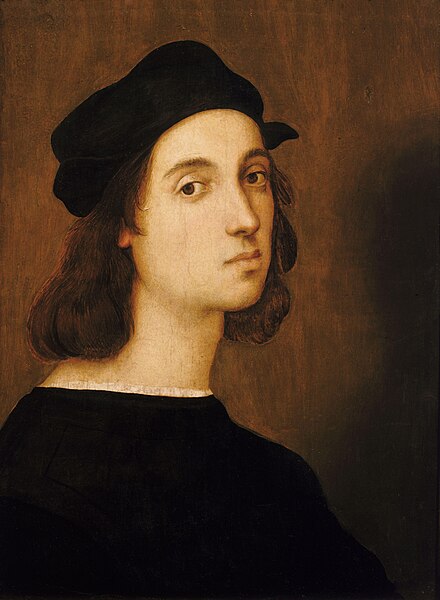
Born: 28 March or 6 April 1483, Urbino
Died: 6 April (aged 37)
Period: Renaissance
The Life of Raphael
Raphael, born Raffaello Sanzio on April 6 or March 28, 1483, in Urbino, Italy, is one of the most admired artists of the High Renaissance. His work is celebrated for its clarity of form, ease of composition, and visual achievement of the Neoplatonic ideal of human grandeur. Raphael’s contributions to art extend beyond his famous madonnas and include significant works in fresco, architecture, and his role in the Vatican’s artistic and architectural projects.
Early Life and Training Raphael was born to Giovanni Santi, a painter at the court of Urbino, and Magia di Battista Ciarla. His father’s connections provided Raphael with an early introduction to the arts. After his parents’ death (his mother in 1491 and his father in 1494), Raphael took over his father’s workshop at a young age, showing remarkable talent.
He trained in the workshop of Pietro Perugino, a leading artist of the time, where he developed a style characterized by clarity and grace. Early works, like the “Mond Crucifixion” (c. 1503), showcase his mastery of Perugino’s style, yet hint at a unique direction in the more expressive emotional content and sophisticated use of perspective.
Work in Florence Raphael moved to Florence around 1504, drawn by the work of Leonardo da Vinci and Michelangelo, who were active in the city at that time. The influence of these masters is evident in Raphael’s development of a more dynamic and expressive style, as seen in his famous Madonnas, which combined ideal beauty with naturalistic detail and warmth, such as the “Madonna del Granduca” (c. 1505) and “La Belle Jardinière” (1507).
Roman Period In 1508, Raphael was summoned to Rome by Pope Julius II to decorate the Vatican Stanze (rooms), an opportunity that defined his career. His work in the Vatican, including the “School of Athens” (1509–1511) in the Stanza della Segnatura, is celebrated for its composition, its wealth of philosophical imagery, and its portrayal of figures like Plato and Aristotle with the faces of Leonardo da Vinci and Michelangelo, among others. These frescoes exemplify Raphael’s unparalleled ability to synthesize the High Renaissance ideals of human grandeur and clarity of form.
Raphael’s influence extended to architecture; he was appointed the chief architect of St. Peter’s Basilica in 1514, succeeding Donato Bramante. Although Raphael’s architectural contributions were limited due to his premature death, his designs and ideas influenced the development of Renaissance and Baroque architecture.
Later Years and Death Raphael continued to work prolifically, producing altarpieces, portraits, and designs for tapestries for the Sistine Chapel, showcasing his versatility and creativity across different mediums. His engagement with antiquity, both artistically and intellectually, also led him to oversee the preservation of Rome’s ancient ruins.
Raphael never married, but he was engaged to Maria Bibbiena, a cardinal’s niece, although the marriage never took place. He is said to have had numerous affairs, the most famous being with Margarita Luti, known as La Fornarina, who appears in several of his works.
Raphael died on April 6, 1520, his 37th birthday, in Rome. His death was mourned throughout Italy, and he was buried in the Pantheon, a fitting resting place for an artist who had so profoundly contributed to the Renaissance’s artistic legacy. His work continued to influence generations of artists, embodying the ideals of the High Renaissance and standing as a pinnacle of artistic achievement.
Raphael’s Notable Works
Raphael Sanzio, a master of the High Renaissance, is renowned for his exquisite paintings, which epitomize the harmony and clarity of the Renaissance ideal. His works are celebrated for their beauty, compositional perfection, and expressive faces. Here are ten of Raphael’s most famous works, which highlight the breadth of his mastery:
- “The School of Athens” (1510-1511) – Part of Raphael’s Vatican frescoes, this painting in the Stanza della Segnatura epitomizes the Renaissance spirit, depicting ancient philosophers and scientists with a mastery of perspective and space.
- “The Sistine Madonna” (1512) – Known for the iconic figures of two cherubs at its base, this masterpiece showcases Raphael’s skill in creating both divine and human tenderness.
- “The Transfiguration” (1516-1520) – Raphael’s last painting, left unfinished at his death, demonstrates his unparalleled ability to depict biblical narratives with emotional depth and dynamism.
- “Madonna del Granduca” (1505) – This painting is one of Raphael’s most revered Madonnas, celebrated for its simplicity, serenity, and the beauty of the Madonna herself.
- “The Triumph of Galatea” (1514) – A fresco in the Villa Farnesina, Rome, illustrating the nymph Galatea surrounded by mythological figures, showcasing Raphael’s mastery of movement and color.
- “Portrait of Baldassare Castiglione” (1514-1515) – A testament to Raphael’s skill in portraiture, capturing the refined elegance and intellectual depth of his subject, a humanist and the author of “The Book of the Courtier”.
- “St. George and the Dragon” (c. 1504-1506) – An early work that already shows Raphael’s talent for dynamic composition and his ability to convey heroic action.
- “Madonna of the Meadow” (1506) – Known for its vibrant landscape and the tender interaction between Mary, Jesus, and John the Baptist, illustrating Raphael’s ability to depict divine and natural harmony.
- “The Disputation of the Holy Sacrament” (1509-1510) – Another of the Vatican Stanze frescoes, this work represents theology and the mystery of the Eucharist with a celestial and earthly assembly, reflecting Raphael’s capacity to merge the divine with the human.
- “La Velata” (La Donna Velata, 1516) – This portrait exemplifies Raphael’s expertise in rendering the texture of fabrics and the subtlety of human expression, capturing the allure and mystery of the woman portrayed.
Raphael’s oeuvre remains a pinnacle of Renaissance art, his paintings revered for their clarity, harmony, and beauty. His influence extended beyond his lifetime, shaping the course of Western art history.